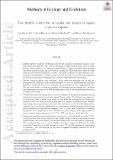Files in this item
Fast, flexible alternatives to regular grid designs for spatial capture-recapture
Item metadata
| dc.contributor.author | Durbach, Ian Noel | |
| dc.contributor.author | Borchers, David Louis | |
| dc.contributor.author | Sutherland, Chris | |
| dc.contributor.author | Sharma, Koustubh | |
| dc.date.accessioned | 2021-11-09T00:41:19Z | |
| dc.date.available | 2021-11-09T00:41:19Z | |
| dc.date.issued | 2021-02 | |
| dc.identifier | 270836703 | |
| dc.identifier | 6ddd1468-ddee-4a00-a97e-fc09dae055d1 | |
| dc.identifier | 000587573800001 | |
| dc.identifier | 85097007927 | |
| dc.identifier.citation | Durbach , I N , Borchers , D L , Sutherland , C & Sharma , K 2021 , ' Fast, flexible alternatives to regular grid designs for spatial capture-recapture ' , Methods in Ecology and Evolution , vol. 12 , no. 2 , pp. 298-310 . https://doi.org/10.1111/2041-210X.13517 | en |
| dc.identifier.issn | 2041-210X | |
| dc.identifier.other | RIS: urn:C1352B12C045516AF8BA49031F204947 | |
| dc.identifier.other | ORCID: /0000-0002-3944-0754/work/83481724 | |
| dc.identifier.other | ORCID: /0000-0003-2073-1751/work/83482039 | |
| dc.identifier.other | ORCID: /0000-0003-0769-2153/work/83482044 | |
| dc.identifier.uri | https://hdl.handle.net/10023/24294 | |
| dc.description | Funding: This work was done to support the Population Assessment of the World's Snow Leopards (PAWS) initiative being coordinated by the Global Snow Leopard and Ecosystem Protection Program (GSLEP) through funding from the Global Environment Facility (Trans-boundary co-operation for snow leopard and ecosystem conservation project ID 5886), made available through United Nations Development Program and International Snow Leopard Trust. ID is supported in part by funding from the National Research Foundation of South Africa (Grant ID 90782, 105782). | en |
| dc.description.abstract | 1. Spatial capture-recapture (SCR) methods use the location of detectors (camera traps, hair snares, live-capture traps) and the locations at which animals were detected (their spatial capture histories) to estimate animal density. Despite the often large expense and effort involved in placing detectors in a landscape, there has been relatively little work on how detectors should be located. A natural criterion is to place traps so as to maximize the precision of density estimators, but the lack of a closed-form expression for precision has made optimizing this criterion computationally demanding. 2. Recent results by Efford and Boulanger (2019) show that precision can be well approximated by a function of the expected number of detected individuals and expected number of recapture events, both of which can be evaluated at low computational cost. We use these results to develop a method for obtaining survey designs that optimize this approximate precision for SCR studies using count or binary proximity detectors, or multi-catch traps. 3. We show how the basic design protocol can be extended to incorporate spatially-varying distributions of activity centres and animal detectability. We illustrate our approach by simulating from a camera trap study of snow leopards in Mongolia and comparing estimates from our designs to those generated by regular or optimized grid designs. Optimizing detector placement increased the number of detected individuals and recaptures, but this did not always lead to more precise density estimators due of less precise estimation of the effective sampling area. In most cases the precision of density estimators was comparable to that obtained with grid designs, with improvement in some scenarios where approximate CV (^D) <20% and density varied spatially. 4. Designs generated using our approach are transparent and statistically grounded. They can be produced for survey regions of any shape, adapt to known information about animal density and detectability, and are potentially easier and less costly to implement. We recommend their use as good, exible candidate designs for SCR surveys when reasonable knowledge of model parameters exists. We provide software for researchers to construct their own designs, in the form of updates to design functions in the R package oSCR. | |
| dc.format.extent | 1360115 | |
| dc.language.iso | eng | |
| dc.relation.ispartof | Methods in Ecology and Evolution | en |
| dc.subject | Camera trap | en |
| dc.subject | Population ecology | en |
| dc.subject | Sampling | en |
| dc.subject | Spatial capture-recapture | en |
| dc.subject | Surveys | en |
| dc.subject | QA Mathematics | en |
| dc.subject | QH301 Biology | en |
| dc.subject | DAS | en |
| dc.subject | BDC | en |
| dc.subject | R2C | en |
| dc.subject.lcc | QA | en |
| dc.subject.lcc | QH301 | en |
| dc.title | Fast, flexible alternatives to regular grid designs for spatial capture-recapture | en |
| dc.type | Journal article | en |
| dc.contributor.institution | University of St Andrews. School of Mathematics and Statistics | en |
| dc.contributor.institution | University of St Andrews. Centre for Research into Ecological & Environmental Modelling | en |
| dc.contributor.institution | University of St Andrews. Statistics | en |
| dc.identifier.doi | 10.1111/2041-210X.13517 | |
| dc.description.status | Peer reviewed | en |
| dc.date.embargoedUntil | 2021-11-09 |
This item appears in the following Collection(s)
Items in the St Andrews Research Repository are protected by copyright, with all rights reserved, unless otherwise indicated.

